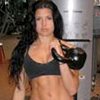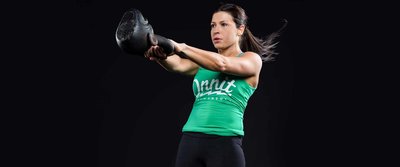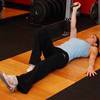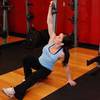What is the best way to develop real strength—the kind that makes you better at everything else you want to do in life? I am firmly convinced it is kettlebell training. When I discovered kettlebells, I was hooked immediately and stopped training with dumbbells and machines. I was amazed at my results, and so were my clients and other trainers. They begged me to teach them what I was doing, and I've spent more than a decade doing just that.
Over that time, the movements I rely on must have become more complicated and esoteric, right? Not at all! What worked then still works now. My favorite moves in 2005, when I first wrote an article for Bodybuilding.com, are some of the same ones I rely on today. Teaching these methods for over 12 years has resulted in thousands of happy people becoming stronger, leaner, and more conditioned.
Another great thing about kettlebell training is that it blends so perfectly with classic bodyweight strength movements like push-ups, pull-ups, and planks. Make no mistake—dumbbells and barbells are incredibly useful and productive tools. But when it comes to building strength and athleticism, your body and a couple of bells are all you need. Here's how to do it.
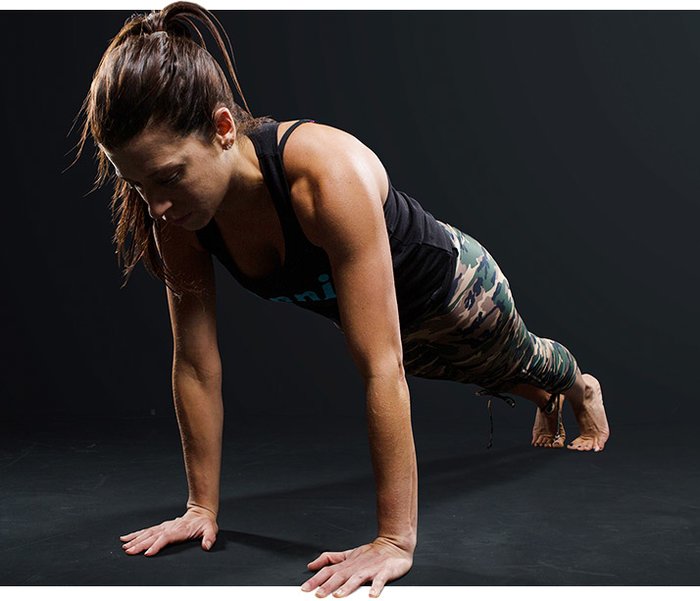
Another great thing about kettlebell training is that it blends so perfectly with classic bodyweight strength movements like push-ups, pull-ups, and planks.
Kettlebell Fundamental 1: Single-Leg Deadlift
Believe it or not, this is my favorite kettlebell exercise. The single-leg deadlift is a great exercise that strengthens the hamstrings, glutes, and back, and is important for both athletic power and back safety. It will teach you the valuable skill of overall tension and staying tight. I've also been known to call it the nonsurgical butt lift, for reasons that will become apparent once you're in the middle of a hard set.
You can start with one kettlebell or two. I prefer starting with two so that you aren't fighting excessive balance issues from the start. If you only have access to one kettlebell, you can also perform this with both hands on that weight.
- Gently stomp your foot into the ground, making sure all five toes are rooted to the floor. It's imperative that your stabilizing leg and heel are firmly planted on the floor.
- Hinge your hips back while also flexing your knee until your back is flat and nearly parallel to the ground. Make sure your back isn't rounding at all!
- As you hinge, the rear leg should be as straight as possible, with minimal knee bend, to keep your spine aligned properly. The torso and the back leg have a seesaw type of relationship, so the higher your back leg goes, the lower your chest goes. Make sure your chest doesn’t drop lower than your than your hips for optimal safety.
- As you hinge and sit deep in to the deadlift position, feel for the bell(s) placed right outside your stabilizing foot. Note: Do not look down at the bell! Your vision should be straight ahead or on the floor 4-6 ft in. front of you.
- Once you are properly hinged and set up, firmly grip the handle of the kettlebell, make sure your shoulder is pulled back so your lat engages properly during the entire movement.
- Exhale and stand up by hinging your hips forward while bringing the bell(s) with you. Lock out your stabilizing leg and squeeze your glute.
Kettlebell Fundamental 2: The Swing
The first kettlebell exercise I start my clients with are drills to help them perform a proper hip hinge, followed by kettlebell deadlifts. Once they can properly execute the hinge, they graduate to kettlebell swings.
The swing is the foundation of kettlebell training. It provides strength and conditioning in a single package, building your glutes, quads, lats, and abs. It also gives you the skills necessary to excel in most explosive kettlebell lifts.
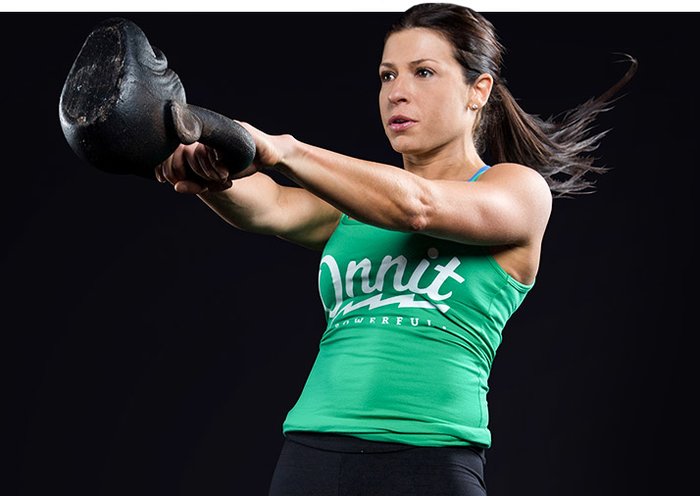
The swing is the foundation of kettlebell training. It provides strength and conditioning in a single package.
My advice: Spend a lot of time perfecting your swings. If yours isn't perfect, consider fortifying it with the one drill that has never failed me or my clients in the past. All you need is a kitchen towel.
Many women start with an 8-kilogram weight and men with a 16-kilogram kettlebell. Some women can start with 12, and some men with 24. Find what feels challenging but not overwhelming to your current strength level or balance.
- Take a natural squat stance, making sure your knees are aligned with your ankles. Root your feet into the ground. Keep your head up and eyes forward.
- Maintain a straight back, even when bending at the hips. To help find this movement, "karate chop" the crease of your hips with your hands to push your hips back rather than down. At the bottom position, you should feel your hamstrings stretch. Remember, it's not a squat; it's a hip hinge.
- Sniff in and hike the bell back, keeping your weight on your heels. Explode through the hips while keeping your arms both straight and loose. Let your hips carry the bell forward. The power comes from your legs, not your arms. Don't try to muscle the swing!
- Lock out the hips and knees at the top position. Squeeze the glutes tight every time you thrust, bracing your abs to protect your spine.
- Your breathing should be a powerful inhale through your nose to your abdomen at the bottom of the swing. As you snap your hips, let out a fast little breath to brace your spine. Don't wait until you're already locked out to exhale. You wouldn't wait until a punch hits to breath out, would you?
There are many variations you can do once you master swings. You can do them heavy with one hand or two for low reps, lighter for a high-rep finisher, alternating between hands, or even with two kettlebells.
Kettlebell Fundamental 3: The Get-Up
I start every day with this exercise. Why? It's a great movement, not just a great exercise. The get-up is a killer for building shoulder stability (and rehabbing shoulders), flexibility, and overall resilience. Commit to it seriously, and you can get seriously strong with this movement. It's perhaps the best total-body warm-up in existence, so consider doing it at the start of a training session.
Unlike the swing, this is a slow drill. Your breathing should be shallow and strong, and be sure to keep your abs pressurized throughout the set.
- Lie on your back and use two hands to press the kettlebell into the air. Keep your elbow locked throughout the duration of the set. Keep the handle at the base of the palm and your wrist straight.
- Step out to the side with the foot on the same side the kettlebell is on.
- Inhale, then roll to the opposite elbow and punch the kettlebell up, keeping your eyes on it. Slide your free arm up onto the hand, propping yourself up. Lift your hip up and bring your opposite leg back behind you.
- Windshield your back foot so you are in a half-kneeling lunge stance. Look forward and press to standing.
- Slowly reverse the movement and return to the floor. Once you are back to the lunge position, keep your eyes on the bell for the rest of the descent.
Bonus: The Front Squat and Goblet Squat
OK, I know I limited myself to three favorite movements in the video, but I can't help but mention the squat here. Kettlebell front-squat variations of all types are outstanding for building strength in the legs, back, and abs, as well as mobility in the hips. This is by far the most practical of all squatting movements. It can be done with one or two kettlebells, either as a goblet squat or front squat, and in multiple double-leg and single-leg variations. Let's stick to the simple goblet for now.
- Hold the kettlebell by the horns. To get it up, start with a two-handed kettlebell swing and "catch" it at the top.
- Take a breath and slowly lower yourself down, using your elbows to push your knees out and open your hips. Only go as low as feels comfortable, and focus on improving your depth over time.
- Pause for a second or two. Pressurize your abdomen and straighten out, pushing steadily through your heels as you ascend back to the top position. Never release all the air in your abdominal cavity at one time.
Bodyweight and Bells
Here is a sample routine combining these three kettlebell movements with push-ups, pull-ups, and planks. In the name of simplicity, I recommend one-minute rests between each set after performing each set of three exercises. If you become fatigued to the point where you lose form, I advise you to stop immediately or go down to a lighter weight.
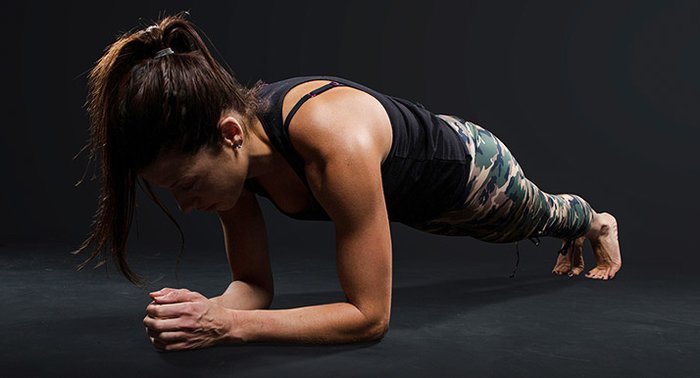
Don't be surprised if your athletic performance improves after a few weeks of adding this type of training into your life. There are endless possibilities of fun and extremely difficult things you can do with just one or two kettlebells, your body, and a few feet of floor space.

BodyFit
$6.99/month- 2,500+ expert-created single workouts
- 3,500+ how-to exercise videos
- Detailed workout instruction
- Step-by-step workout tips
- Training at gym or at home
- Access to Workout Plans
- Access to Bodyfit App
- Store Discounts
Already have a Bodybuilding.com account with BodyFit? Sign In

What comes with BodyFit?

- Instructional Videos
Don't risk doing a workout improperly! Avoid injury and keep your form in check with in-depth instructional videos.

- How-to Images
View our enormous library of workout photos and see exactly how each exercise should be done before you give it a shot.

- Step-by-Step Instructions
Quickly read through our step-by-step directions to ensure you're doing each workout correctly the first time, every time.
Use a bell that is challenging, yet allows you to move quickly. Make it look good.
